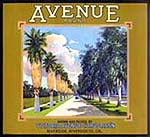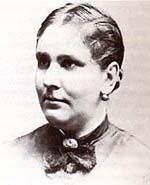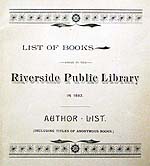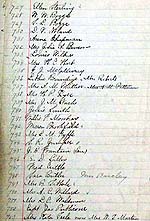
Historical Scrapbook:
RIVERSIDE LIBRARIES 1873-1903
Riverside Free Public Library 1888-1903

Mary Montague Smith.
She was first City Librarian. She was educated in the Bradford Academy, MA. She died in December 1900.
Photo from Baker, 1988.
Card holders record book, 1889. All library official records were written in the beautiful handwriting required to be mastered by all librarians.
Image courtesy of the Riverside Public Library.
In 1850, the British Parliament passed what became known as the Public Libraries Act. The act allowed towns with over 10,000 citizens to levy a tax of “a half-penny in the pound” for the construction and maintenance of public libraries. However, the benefit of public libraries to the wider society was still a hotly disputed issue in Great Britain. In the United States, the concept of public libraries was closely connected to the philosophy of democracy as one of the founding principles of the country. As James Thompson (1977) aptly formulated in his book about the history of librarianship, the United States believed that the “democracy could only be won and maintained … through democracy of education and education for democracy” (p. 95). Besides the schools, the libraries were seen as the main tools of self-education, social and cultural embetterment—not the least as main defense against the spread of moral and social evil. The legislation that regulated the right of the municipalities to levy the taxes in United States was a matter of state governments and many of them, particularly in New England, readily adopted the appropriate legislation. In California, such a statute was enacted in 1878.
When the City of Riverside incorporated in 1883, Elmer Holmes, the founder of the Library Association, becomes a member of the City Board of Trustees. He proposed several times that the Association donate its book collection to the City, which would then organize and maintain a free public library. However, at that time the city was in turmoil over a dispute about water rights and prices, and quite unwilling to deal with the question of a public library (Baker 1988, p. 6).
By 1888, the question of water was resolved, Holmes was elected the chairman of the City Board of Trustees, and the Library Association shareholders agreed to donate their collection to the City. Although the collection contained almost 1,000 volumes, the books were in quite a bad shape and many of the volumes required rebinding. According to the history of the Riverside Public Library, written by Holmes himself and published as the part of the 1902 Finding list of books, “the city board promptly accepted the gift.” However, the contemporary newspaper report from the July 9, 1988 meeting, describes a much more reluctant Board of Trustees. At the meeting, some of the Board members proposed to put the library in the YMCA building, but Holmes thought that the YMCA could have a problem with some of the books in the collection. He was also sure that he was not the only Association shareholder who is strongly against “any sectarian influence” over the library collection. In the end, the Board of Trustees agreed to form an independent library and appointed the members of the Association’s Library committee as the members of the Public Library committee. However, the question of providing for the finances, rebinding, and space were referred to some future time.
Eventually, the City Board agreed to finance the library with money collected with the tax levy of one-half mill on the assessed dollar (Baker 1988, p. 10). The Library Board with the Reverend George H. Deere, as its president, chose Mary Montague Smith as the first City Librarian. She was graduate of the Bradford Academy in Massachusetts and the widow of Reverend G. L. Smith, a local minister in the Congregational Church. Although the Library Board’s main intention was to provide for the livelihood of the respected widow, as it happens, they made an excellent choice. Mary Smith was one of those people who was “born to be a librarian.” She did not have any formal library training, but the quality of her education prepared her well for her position. Under her management, the haphazard book collection became a well-organized library, eventually even catalogued using the Dewey Decimal System. On June 1, 1888, the library opened with 1,000 newly rebound volumes; and by 1900, when Mary Smith died a premature death, the library was bursting at the seams with 10,000 volumes.
At first, the library operated in two small rooms on the second floor of Handy Building. The space was cramped and did not provide for a reading room. However, as soon as the construction of the Loring building, on the corner of Main and Eight, was finished, the library moved there to more spacious quarters. At the beginning, there were small glitches here and there, but the space was well suitable for library operations. The building was at the heart of the town, and storefront position provided for well-lighted reading room. Riverside Daily Press Annual from 1891 proudly describes the library and its reading room:
In the front portion of the room a space some 45 feet square is set apart as a reading-room, where the citizens or transient resident is welcome to make use of the reviews, magazines, and daily and weekly newspapers from all portions of the country. This room is nicely finished, well lighted, and is open for the public each week day, from 9 to 12 o’clock in the evening, 1 to 6 in the afternoon, and 7 to 9 in the evening. The books upon the shelves, as well as the periodicals are for the free use of all… The liberal management of this institution makes it one of Riverside’s strong attractions to people of culture” (p. 36).
Obviously, by 1891, the library hours were extended by popular demand, because in the regulations published in the 1889 library catalogue, the library was supposed to be open only on Tuesday, Thursday, and Saturday afternoons from 2 to 6, and Saturday evenings from 7 to 9 o’clock. Any resident fourteen years and older could become member and borrow one book at the time. The “transient persons,” most of them guests of the Glenwood Hotel (later Mission Inn) were allowed to borrow a book at the price of two cents per day. The residents who did not live in the incorporated area were required to pay a membership fee of $1 every quarter of the year. Although the magazines and newspapers in the reading rooms were freely available, “no book can be taken from the shelves by any one except the librarian” (rule 8). Until the end of the century, books were in closed stacks and patrons needed to “call for a book by a title” and wait for the librarian to retrieve it from the shelves. As the library did not yet have a card catalog it was strongly suggested that patrons buy the catalogue (“the price of which has been made less than its actual cost to the library”) and decide on the book titles at leisure in their own homes (Finding List of Books 1893, p. 2). Following the “Section 623 of the Penal Code,” any mutilation of library property – book, picture, chart, or apparatus – was considered a felony and prosecuted accordingly. Rules changed over time: by 1902 any Riverside citizen twelve year and older could borrow a book, and 1909 that privilege was extended to eight year olds. Some library rules are eternal: then, the same as today, books could be borrowed only for a period of two weeks and renewed only once, provided that they are not overdue.
The library was very popular among the citizens of Riverside and in 1892, according the Riverside Daily Press Annual “the monthly average [of book circulation] for the year has been 2,765, and for past few months it has reached 3,000” (p. 6). In the town that had less than 5,000 citizens (RPL, Local History Office), this was astonishing.
However, in this period the library also started to develop other library services. Smith made borrowing of children books as friendly as possible, but children were not allowed to check books out by themselves. Teachers were issued special “teachers cards” and allowed to borrow up to five books for use in the classroom (Baker 1988, p. 8). This was also the time when the “local history” collection was started, which seems to be the personal initiative of Albert White. The library also maintained the connection with the wider librarian community and readily cooperated with other libraries. In 1897, Smith becomes a member of the California Library Association and in 1898, the library joined with UC and several other public libraries to form the first ILL network in California. In 1893, the non-fiction library stock was classified according to the Dewey Decimal System.
However, Mrs. Smith and the Library Board were of the conviction that the public was borrowing too many fiction books, which did not square with the mission of public libraries as houses of learning and moral uplift. The Library Board did not actually censor the books out of the stacks, but decided to make any borrowing of fiction inconvenient as much as possible. One could borrow two books, provided that one of them was non-fiction; while non-fiction books were in open stacks, the fiction was still on “call number” system and the book needed to be retrieved by the staff. In 1896, the Library Board also sharply reduced the budget for the purchase of fiction books.
As elsewhere in America, this intellectual engineering was not popular with the library patrons. Denied the popular reading, circulation in the library plummeted. To make things worse, the library started to outgrow its space in the Loring building, but the library’s requests for additional funds was denied by the City Board of Trustees. In 1899, placed between a rock and a hard place, the Library Board abandoned restrictive fiction books policies and canceled “call number” system. With its popularity improved, the library managed to wriggle more funds from the City Trustees and rent additional space in the Loring building. But this provided only a temporary relief from the space crunch.
At the turn of the century, the public libraries become more than just collections of books. Libraries were developing into institutions as we know them today: with its own standards, schools, cataloging systems, and variety of other social and community outreach services. The new libraries needed the new buildings.
Text, design, and digital imaging by Vlasta Radan.
Last update May 4, 2006.


